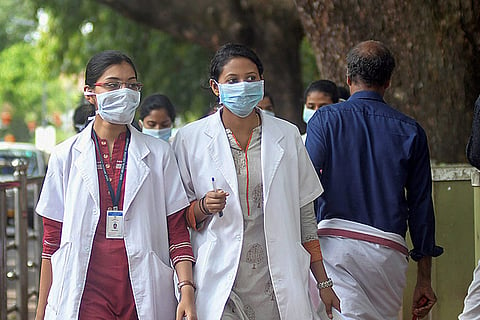

It was on June 2, a lazy Sunday, that Kerala heard the news this time that Nipah was suspected in a 23-year-old youth.
The youth, hailing from north Paravur, had been admitted at Aster Medcity, a private hospital in Ernakulam, with fever on May 30. On June 4, Health Minister KK Shailaja announced that Nipah was confirmed after samples from the youth were tested at the National Institute of Virology, Pune. The state health machinery almost immediately rose up to the occasion.
The Nipah symptoms in the youth were more neurological. Aster Medcity got samples tested at a private lab in Bengaluru, isolated the youth, and immediately informed the health department.
In a story that can well be added as yet another inspiring chapter in Kerala’s much acclaimed health model, the state successfully fought the virus this time. The youth is to be discharged on Tuesday. A small function has been planned at the hospital in which KK Shailaja will also take part.
“He is normal and healthy. I visited him a few days back,” Dr NK Kuttappan, Ernakulam District Medical Officer tells TNM.
When the Nipah virus was first identified in the state, in Kozhikode in May 2018, it led to an outbreak that claimed 17 lives. But the lessons learnt from last time enabled the state to put together a robust system, that was forever watching out for any patients with symptoms.
The fight began at the right time, at the right level
The media in the state as well the national media had keenly awaited news of confirmation of the disease. “But the government made it public only after the health system was prepared, after all the basic coordination was done, and of course after confirmation from Pune, the only authorised institute accredited by the Indian Council of Medical Research for Nipah confirmation. Health officials from the top to the bottom were given strict directions not to pass any half-baked information and it was made clear that information should be disseminated only from one point,” a source tells TNM.
A control room was opened at the district collectorate for surveillance, with a round-the-clock contact number for the public to seek assistance and to pass on information about those with fever or similar symptoms. From June 3, Shailaja and Rajan N Khobragade, Principal Health Secretary who had replaced Rajeev Sadanandan (the civil servant who was the Health Secretary during the first Nipah outbreak), began camping in Ernakulam.
A team of health officials from Kozhikode rushed to Ernakulam under the coordination of UV Jose, the former Kozhikode collector who along with his team won accolades for handling the ever first Nipah outbreak in a mature way.
The Health Minister regularly held press meets for the first four days till the sample results of the six suspected cases came back negative on June 6. The then District Collector Mohammed Y Safirulla conducted the press meets till the situation eased.
Dr Kuttappan attributes this time’s success mostly to the experience gained from the first outbreak.
“We had developed a treatment protocol based on the Kozhikode experience. As many as 15 committees had been formed with officers given charge of each committee which turned out to be a huge help. Surveillance had been done at three levels – first, field staff who went in person and met people in the patient’s contact list; second, integrated disease surveillance programme (ISDP), which strengthens disease surveillance for infectious diseases, to quickly detect and respond to outbreaks; and third, surveillance through control rooms. All these were to prevent the virus from spreading to more people,” Dr Kuttappan explains.
As many as 330 people whom the patient came in direct and indirect contact in three districts were traced. A native of Ernakulam and student in Idukki, the youth had been to Thrissur for an internship.
‘Everybody cooperated’
Dr Kuttappan emphasises that the cooperation of the people on the contact list made things easier. “During surveillance days, as per our directions they did not step out of their homes without any complaints,” he says.
The people in the contact list included those from Alappuzha, Kottayam and Kollam districts too. Thirty wards were opened at the Government Medical College Kalamassery, where the people were quarantined.
“The ward did not affect the other functioning of the medical college. Special staff and separate ambulance services were deployed solely for the isolation ward and there was a separate exit and entry too. Training for the ambulance drivers was given by Dr RS Gopakumar, health officer, Kozhikode Corporation, who conducted the funerals of the 2018 Nipah victims,” Dr V Meenakshy, additional director of public health, tells TNM.
Isolation wards were also opened at other government medical colleges in the state.
“A point of care test lab was opened at the Medical College Kalamassery, where a scientist from NIV Pune conducted the tests on samples from suspected patients. “If the results were positive, it would then be sent to NIV Pune for confirmation and if it was negative, the samples would be sent to Institute of Virology, Alappuzha for testing other viral parallels,” she adds.
A team from the Centre consisting of experts from MCI and the Indian Council of Medical Research also arrived to lend support. “The team coordination was very effective and without any hassles,” Dr Kuttappan says.